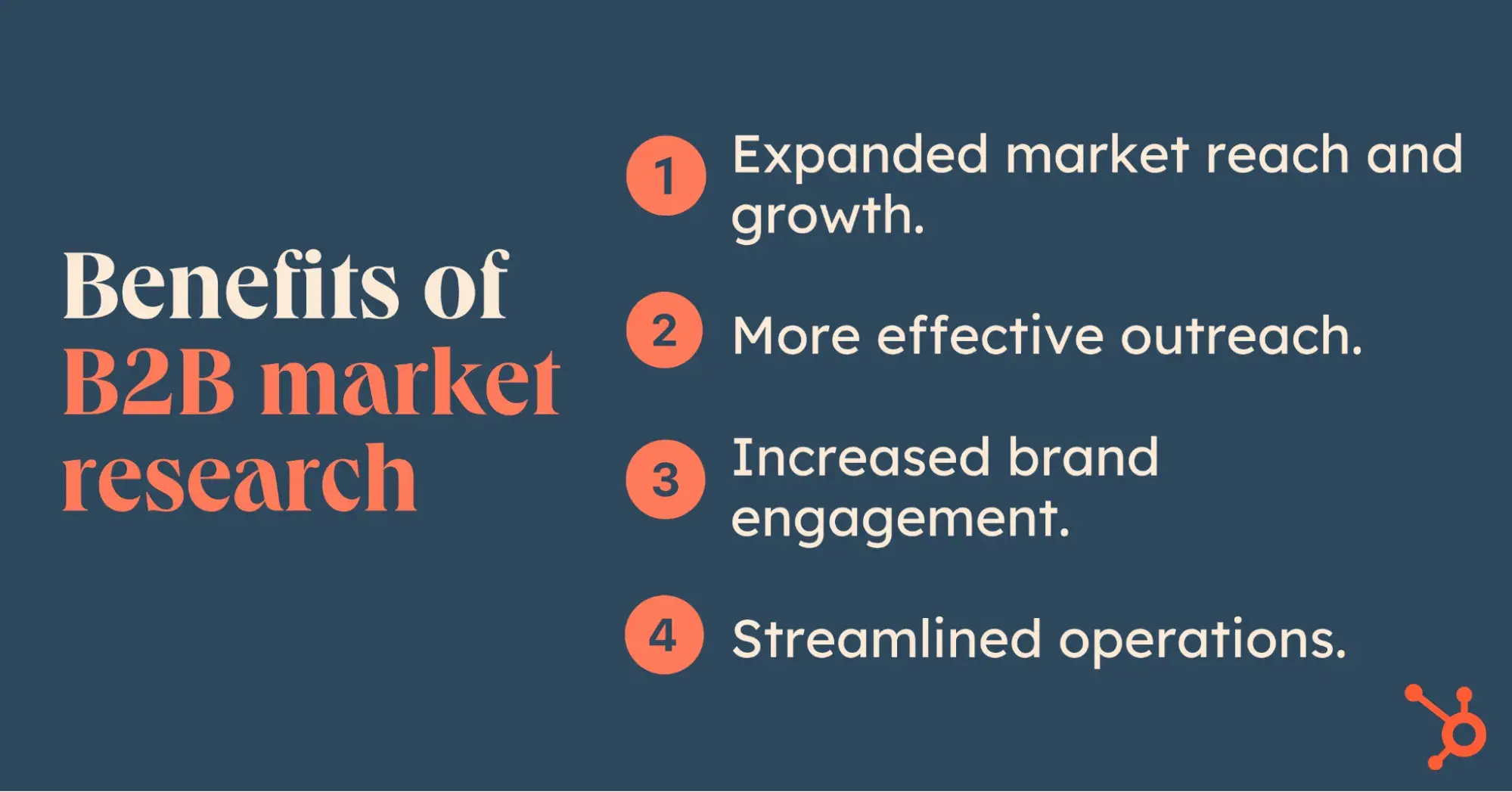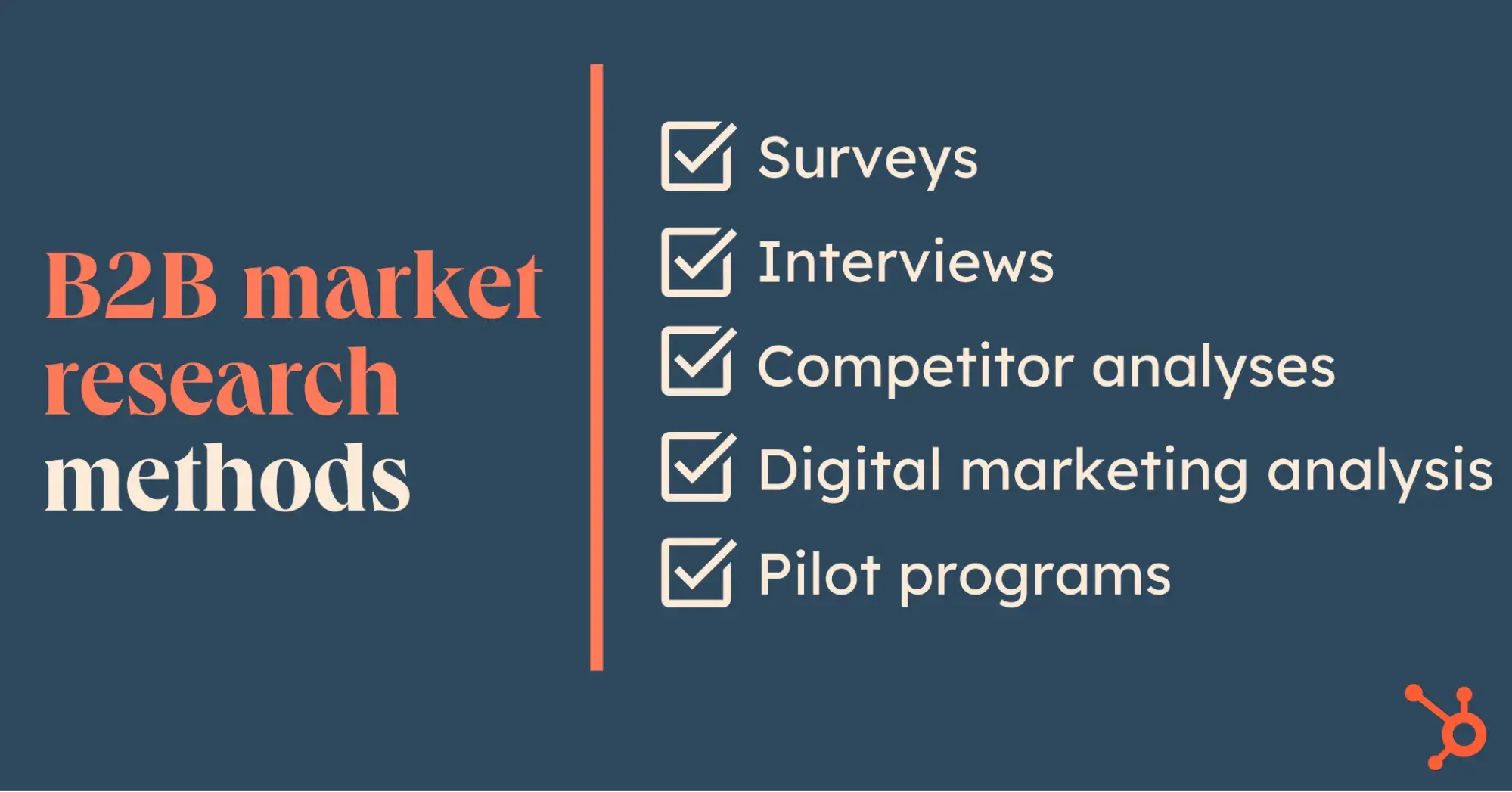Conducting B2B Market Research the Right Way — Here‘s Everything I’ve Learned

Few things bring me joy like diving into a Wikipedia rabbit hole for a few hours. I relish the chance to research topics and ideas and discover the unexpected ways they connect.

And while I may relax that way in my personal life, I also use those skills in business, where I conduct B2B market research to build marketing strategies and plans.
Understanding businesses as buyers is its own kind of rabbit hole. They can be complex entities, with dozens or hundreds of employees and leaders, each possessing unique needs and desires.
It’s a lot to unpack — but, to thrive in the modern marketplace, knowing your buyer is the foundation.
Let’s chat about how you can learn about B2B buyers and how market research can equip you and your team for success.
Table of Contents
Market research uncovers important information like:
How companies view their industry and the marketplace for your products.
What company leaders need and want from a particular vendor.
Where they are in the buying cycle and what it’ll take to move them along.
B2B market research requires both quantitative (hard, numerical) and qualitative (softer, subjective) data. The end goal is to prepare your company to best position your offerings with your target business market.
We’ll get to specific methods of conducting B2B market research later. But items like surveys, competitive analyses, and customer interviews will provide the data you need to make the best decisions.
B2B Market Research vs. B2C Market Research
If B2B market research is how you understand companies as consumers, then B2C market research is how to discover the same details from consumers themselves.
What makes them different, and when should you use each?
Buying Complexity
Both the target audience and product marketplace are more complex in B2B buying scenarios.
With B2C buying, you’re selling directly to one consumer. They — or perhaps along with a spouse, partner, or other family member or friend — are the ultimate decision maker.
For instance, if you’re buying a new car, you may include your spouse or partner in viewing and test driving vehicles. But the car dealership is selling to you, the ultimate buyer. The product or service is therefore straightforward: Here’s the car with certain features and the price.
B2B buying gets complex quickly. Usually, B2B products are more complicated.
They require multiple stakeholders to get invested in the process, and they reach across several departments. Consider integrating a new CRM across an enterprise.
That change will affect a lot of employees.
As such, B2B buying happens as a committee effort. The average B2B buying committee has around 11 people, according to Gartner. B2B sellers need to “multi-thread” their deals by working alongside all these interested parties to close the deal.
Decision Making
The differing levels of complexity affect how buying decisions are made.
B2C transactions typically happen quicker. Now, buying a car is usually a multi-week affair. Instead, let’s consider your last trip to the grocery store.
How long did you spend deciding to buy, let’s say, a box of Hamburger Helper? If you’re like the average consumer, that’d be 13 seconds.
These decisions also tend to be more impulsive or emotionally driven. You’re hungry (bonus tip: never shop hungry). And Hamburger Helper sounds delicious. So, you transact and buy a box for dinner.
B2B transactions involve more people and deeper research and consideration. Ergo, they take longer. The typical B2B cycle can run from a few weeks to 3-9 months, depending on what you’re buying. Personally, I’ve seen these decisions take years to fully flesh out.
Because you’re in it for the long haul, B2B buying also relies more on relationships and trust. Buying dinner from the grocery store doesn’t require a nurture cycle. But if I’m trusting a vendor with my enterprise’s new CRM (and potentially hundreds of thousands or millions of dollars), I need to believe they’re the best fit.
Emotions can play a role — you want to like who you’re buying from. But these are often more rational buying decisions, focused on business needs, ROI, and value propositions.
Preferred Research Methods
Perhaps one of the most important differences between B2B and B2C market research is how you acquire data for decision-making. While both types use quantitative and qualitative data, they use that information differently.
For instance, B2C market research is typically more quantitative-driven.
Researchers use consumer surveys and polls to gather information. They want to capture a diverse consumer base, so the number of participants is high.
B2C researchers seek “statistical significance,” which means they received enough responses from consumers to apply their findings across the broader consumer base. The number to reach significance should be about 10% of your target population. For most research, that falls between 100-1,000 respondents.
Conversely, B2B researchers probably dream of convincing 1,000 businesses to respond. Business markets are usually more niche, meaning they have fewer potential respondents for surveys. Plus, business buyers often hold information closer to their chests; they don’t want proprietary data to leak.
B2B market research is therefore more qualitative-driven. Researchers use more in-depth surveys, prospect interviews, and focus groups to gather intelligence.
They’ll target questions to get to the real meat of the matter. What are the deepest pain points? And what do leaders need and want to solve it?
You’ll also see researchers place greater weight on responses based on a respondent’s influence over a final decision. The CEO’s answers will mean more than the Marketing Manager’s.
If you’re struggling to get high-quality information from your B2B sources, hear what B2B International has to say.
And, if you’re craving more about the B2B/B2C split and how B2B buyers view the market, see our latest data-packed research report on B2B buyers.
Benefits of B2B Market Research
Conducting market research should deliver a lot of benefits. But which ones can help companies the most right now?
To answer this, I talked with Theresa Goodwin. She’s the CEO of Boldthink, a brand consultancy. Goodwin shared several benefits recent clients have received from B2B market research.

1. Expanded Market Reach and Growth
Regular research helps your company grow: professional services marketing firm Hinge found companies that conduct B2B market research at least quarterly grow up to 70% faster and are almost 50% more profitable than firms that don’t.
You can also reach new markets or expand into current ones with good research.
One of Goodwin’s clients wanted research into their employer brand and how to use it to attract more clients and employees. Through primary and secondary research, Goodwin’s company helped the business redevelop their employer brand, gaining market share within talent pools.
2. More Effective Outreach
Market research also helps you talk to the right companies and people for growing your business.
For instance, Goodwin’s client saw a surge in applications from qualified talent who aligned with the company’s values.
“By connecting with the right talent, they didn’t just hire more people, they hired people who wanted to stick around,” she said.
3. Increased Brand Engagement
Across digital and physical channels, Goodwin’s client saw more people interact with their brand. What’s more, employees began advocating for the brand. They actively shared their brand experiences — further attracting like-minded talent.
4. Streamlined Operations
It’s easy to overlook internal benefits. But, the process of understanding buyers and the market can help standardize operational needs.
“The new materials we developed made things like RFPs and proposals more efficient for their internal team,” Goodwin shared. The client could do more thanks to a clear understanding of their business and positioning.
B2B Market Research Methods
A good B2B market research report will use primary and secondary sources and quantitative and qualitative data to develop insights. How do you get that information? I’ll cover some of the most common research methods below.

1. Surveys
A B2B survey should gather crucial information on your potential buyers like:
Company profile.
Needs and challenges.
Product or service use.
Decision-making process.
Details and perceptions on the industry.
B2B surveys don’t need the same level of statistical significance that B2C surveys require. But, you do need enough business leaders to respond.
You can expect a response rate for a B2B survey between 10-30%. Make sure you reach out to a lengthy list of potential respondents to gather sufficient data.
2. Interviews
Use customer interviews to collect highly detailed qualitative information. You can handle this process within focus groups or individual interviews.
You can get a lot of great info from interviews, but you don’t have as much control over the process. Customers can go off on tangents or wander into unexpected territory. Goodwin says that can be a good thing.
“Embrace the messiness of the process,” she said.
“Not every conversation will go as planned, and sometimes unexpected insights will pop up that challenge your assumptions. Be ready to pivot and adjust your approach as you go. Flexibility is key and sometimes the best insights come from the conversations you didn’t anticipate.”
3. Competitor Analyses
Know where your company sits in relation to your competitors. Price, product features, and customer support are all differentiators your buyers will care about.
Also evaluate more qualitative elements like competitors’ marketing portfolios and value propositions to get a better sense of who they are and what makes you unique.
Pro tip: Generative AI can help collect and crunch competitor data to produce a solid competitive analysis. Tools like ChatGPT can parse through publicly available documentation and uncover new insights into competitors.
4. Digital Marketing Analysis
Review publicly available information online about your industry, competitors, and potential buyers. Everybody is posting something, so look into some of the most common places:
Social media like Facebook, X, Instagram, LinkedIn, and TikTok.
Websites hosted by competitors and buyers.
Aggregate sites like G2 that provide public data on products and services.
Pay close attention to engagement on social media (i.e., How many likes did your competitor’s latest posts generate?). Also, if you have access to SEO research tools, dig into keyword use. Google Trends offers a fine top-level place to begin.
5. Pilot Programs
If you’re launching or revamping a product or service, offer pilots to current or potential customers. You can gather significant amounts of data — especially qualitative data and valuable testimonials.
Don’t forget to interview program participants after their pilot ends.
Pro tip: If you’re ready to get going with any of these research methods, or want to dig deeper into market research how-tos, our market research guide can help.
When you’re ready to start B2B market research, follow these steps to prepare you and your organization for success.
Step 1: Define research objectives.
If you want solid insights at the end, lay a good foundation at the beginning, and clearly define what you’re seeking to accomplish with your B2B market research.
Think of objectives like:
Understanding market size.
Identifying customer needs.
Analyzing competitors’ strategies.
You won’t know what the result will look like yet, but establish objectives to begin.
Step 2: Set target audience.
Build the boundaries for who you want to respond to your research outreach.
Filters could include:
Geographic location.
Industry type, including niche options.
Company size and makeup.
Leadership level for ideal respondents (e.g., VP of Marketing or CMO).
A target audience with these types of boundaries will help you capture an accurate slice of your larger market.
Step 3: Conduct primary and secondary research.
Depending on your objectives and target audience, start digging into available data. Secondary research like industry publications, public data sets, and reports from government agencies and market research firms offer ample information.
If you want to get specific, however, include primary research, too. Surveys and interviews can provide a qualitative boost to your research.
Pro tip: Explore HubSpot’s list of market research tools to help you gather data and analyze for insights.
Step 4: Assess success metrics and insights.
See how the information you gathered fits into your objectives. Did you capture the right kinds of data? How did it match up to your goals? What did it all reveal?
Qualitative data can offer a big boon to your business. Goodwin and her team share this fact with clients.
“I measure the success of a B2B market research project by the insights it brings to the table,” Goodwin said.
“Success isn’t just about confirming what we already know — it’s about uncovering something new. Did we have that ‘aha’ moment? Did we find the answers to our core questions that validate or challenge our assumptions? If the research leads to actionable insights that inform strategy or drive decisions, then it’s been successful.”
Conducting My Own B2B Market Research
When I’m building B2B market research plans, I lean on a few tips to remember during the process. I also asked Goodwin for some of her feedback on running these programs.
Foster comfortable, engaging interview environments.
In the past, I did a lot of thought leadership development, which included acting as a journalist. I’d interview subject matter experts and transform their ideas into actionable insights. You want that kind of journalistic flair when you run research interviews.
Goodwin elaborates on this point: “Asking people for specifics encourages them to go beyond surface-level responses and makes the conversation more personal and relevant to them,” she said.
“This allows you to dive deeper and get insights you may not have otherwise gotten from just asking one question. Plus, it helps them feel more comfortable knowing there isn’t a right or wrong answer because it’s all about their unique perspective.”
Pro tip: Goodwin also cites “Buyer Personas” by Adele Revella as a fantastic guide for preparing and running top-notch buyer interviews. “It taught me how to structure my conversations, dig deeper, and make interviews feel more natural rather than scripted,” she said.
Proactively handle organizational impatience.
Doing great research takes time. There’s lots of ground to cover when planning objectives, conducting research, and compiling results.
During this process, people can get antsy. Leaders may expect results sooner than you’re ready (or able) to share. Everyone wants juicy insights, but you have to earn them.
Goodwin sometimes sees this impatience with her clients and has developed her own approach to that conversation.
“My favorite saying is, ‘We have to slow down to speed up,’ and I use it every time I explain my market research process. Rushing through research can lead to costly do-overs later, so investing time upfront saves resources in the long run,” she said.
“When clients understand this, they see the value in letting the process unfold. If a client insists on moving quickly, I set clear expectations and explain that insights will be limited and could impact the strategy’s effectiveness. That way, they understand what they’re sacrificing for speed.”
Develop Your B2B Market Research Acumen Today
B2B market research requires diligence, patience, an eye for detail, and a keen interest in understanding data and relationships. When leadership wants answers yesterday, all of this can feel overwhelming.
But, conducting market research can be an enlightening experience. You hear directly from customers and prospects. And you can lead fascinating conversations that take unexpected but interesting turns.
All in all, B2B market research can be fun.
With the many tools and techniques available online, you can start conducting deep research into your target market, audience, and potential business customers.
Set two or three targeted research objectives and start seeking the unexpected today.
![→ Download Now: Market Research Templates [Free Kit]](/wp-content/uploads/Conducting-B2B-Market-Research-the-Right-Way-—-Here‘s-Everything.png)



